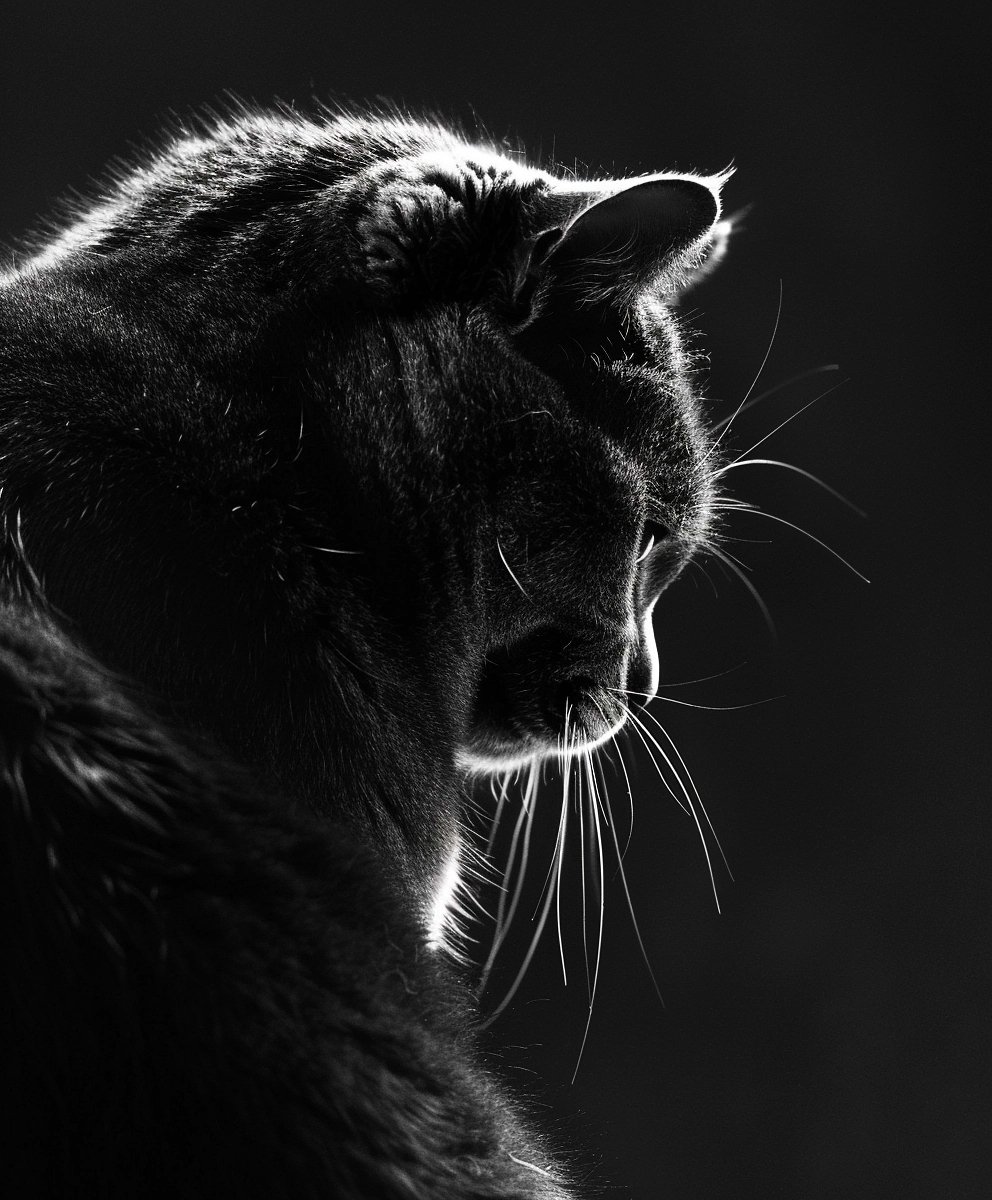Low blood sugar, or hypoglycemia, in cats is a serious condition that can lead to significant health issues if not addressed promptly. To ensure your feline friend’s well-being, you need to understand the signs and causes of low blood sugar. Symptoms may range from lethargy to severe cases like seizures or loss of consciousness, making it vital to monitor your cat’s health closely.
As a caring pet owner, you should be aware of the risk factors that can lead to hypoglycemia, such as diabetes management or underlying health problems. Timely diagnosis and treatment are essential to prevent complications. With some knowledge and vigilance, you can play a pivotal role in your cat’s health journey.
Keeping an eye on your cat’s behavior and recognizing the symptoms early can make all the difference.
By the end of this article, you’ll be equipped with the information needed to understand and manage low blood sugar effectively.
Key Takeaways
- Hypoglycemia can cause lethargy, disorientation, and more severe symptoms in cats.
- Early detection and treatment are crucial for recovery and preventing complications.
- Regular monitoring and proper management of underlying health issues can help maintain stable blood sugar levels.
Understanding Hypoglycemia
Hypoglycemia in cats is a serious condition where blood sugar levels drop below the normal range.
It’s important to identify the causes and understand how the pancreas plays a vital role in regulating these levels.
Defining Low Blood Sugar
Low blood sugar, or hypoglycemia, occurs when your cat’s blood glucose levels fall significantly.
Normal blood glucose levels typically range from 80 to 120 mg/dL.
When levels drop below this range, your cat can experience symptoms like lethargy, disorientation, and in severe cases, seizures or even coma.
Monitoring your cat is crucial, especially if they have underlying health conditions.
Regular veterinary checks can help prevent hypoglycemic episodes.
If you notice signs like shakiness or confusion, it’s important to address them promptly, as prolonged low blood sugar can be life-threatening.
Causes of Hypoglycemia in Cats
Several underlying conditions can lead to hypoglycemia in cats.
Common causes include:
- Diabetes Mellitus: Insulin treatments for diabetes can sometimes lower blood sugar excessively.
- Insulinoma: This rare tumor in the pancreas produces insulin uncontrollably, causing severe drops in blood sugar.
- Pancreatitis: Inflammation of the pancreas can affect its ability to regulate insulin, resulting in low glucose levels.
- Cancer: Some tumors can interfere with glucose metabolism.
Dietary issues, like fasting or not eating enough, can also contribute.
Cats with these conditions require careful management, including regular feeding schedules and monitoring of their blood glucose levels.
How the Pancreas Influences Blood Sugar Levels
The pancreas plays a key role in glucose regulation.
It produces insulin, a hormone that helps your cat’s body use glucose for energy.
When your cat eats, the pancreas releases insulin to lower blood sugar levels after meals.
If your cat is diabetic, the balance of insulin can be thrown off, either through excess production or insufficient amounts.
The pancreas also releases glucagon, another hormone that raises blood glucose when needed.
Maintaining a healthy pancreas is critical for stable blood sugar levels.
Regular checkups can detect issues early, helping to prevent the onset of serious conditions like diabetes or pancreatitis.
Identifying the Signs

Recognizing low blood sugar in cats is essential for timely intervention.
By understanding the symptoms, you can act quickly if your cat’s health is at risk.
Early Symptoms of Hypoglycemia
In the early stages of hypoglycemia, your cat may display subtle signs that can easily be overlooked.
Common early symptoms include weakness and lethargy.
You might notice your cat tiring more quickly than usual during play or sleeping more often.
Other indicators include disorientation and a decrease in coordination.
Your cat might seem confused, bumping into objects or having trouble jumping.
Increased appetite could also be a sign, as your cat instinctively tries to compensate for low blood sugar.
It’s important to monitor your cat closely for these signs, as they can escalate quickly into more severe symptoms if left unaddressed.
Recognizing Severe Hypoglycemia
Severe hypoglycemia can manifest rapidly and poses serious risks to your cat’s health.
When blood sugar levels drop significantly, symptoms can escalate to seizures and loss of consciousness.
You may witness your cat shaking, having convulsions, or appearing unresponsive.
In extreme cases, hypoglycemia can lead to coma or even death if not addressed immediately.
Immediate veterinary intervention is crucial during these episodes.
Be prepared to provide your vet with details about your cat’s symptoms and any underlying health conditions.
Recognizing these critical signs can save your cat’s life.
Risk Factors and Prevention
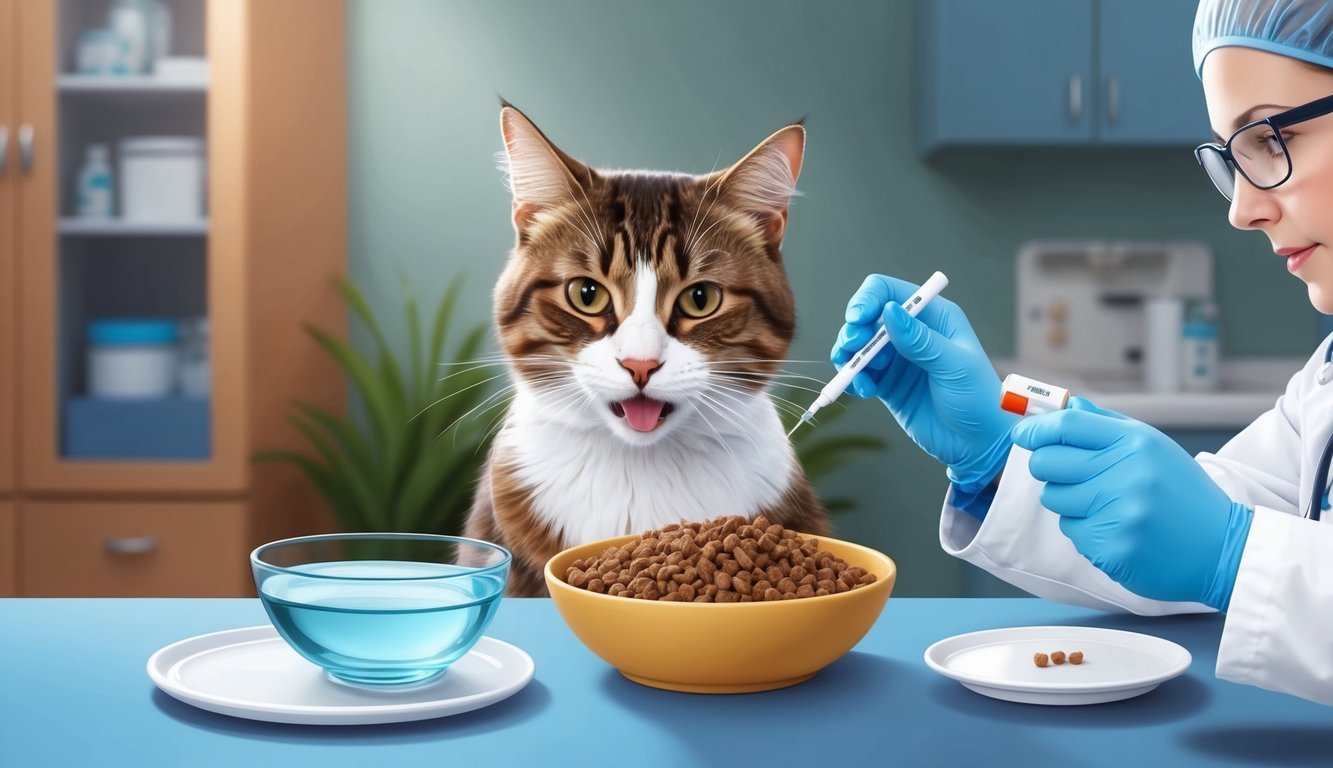
Understanding the factors that can contribute to low blood sugar in cats can help you take proactive steps to safeguard your feline’s health.
Consider both the common risk factors and effective preventative measures to reduce the likelihood of low blood sugar episodes.
Common Risk Factors
Several factors can increase the risk of low blood sugar in your cat.
-
Age: Older cats may have altered metabolism and health issues that predispose them to hypoglycemia.
-
Obesity: Overweight cats are more likely to develop diabetes, which can lead to potential insulin-related complications.
-
Insulin Overdose: If your cat is diabetic and receiving insulin, administering too much can drastically lower blood sugar levels.
-
Carbohydrate Diet: Diets high in carbohydrates can cause fluctuations in blood sugar levels, especially if not properly managed.
-
Low Exercise: A sedentary lifestyle can contribute to obesity and insulin resistance, increasing the risk of hypoglycemia.
-
Weight Loss: Rapid weight loss can also impact your cat’s insulin levels and overall metabolism.
Preventative Measures
There are several strategies you can implement to prevent low blood sugar in your cat:
-
Monitor Diet: Ensure your cat’s diet is well-balanced, focusing on protein and healthy fats while controlling carbohydrates.
-
Regular Vet Check-Ups: Frequent visits to the vet can help identify health issues early and adjust insulin dosages as necessary.
-
Consistent Feeding Schedule: Feed your cat at regular intervals to maintain stable blood sugar levels.
-
Adequate Exercise: Encourage daily physical activity tailored to your cat’s ability to help maintain a healthy weight.
-
Weight Management: Keep a close eye on your cat’s weight. Consult your veterinarian if you notice significant weight changes.
-
Educate Yourself: Understanding insulin administration and its effects will help prevent accidental overdoses.
By recognizing these risk factors and incorporating preventive measures, you can help protect your cat from the dangers of low blood sugar.
Diagnostic Approach
When dealing with low blood sugar in cats, it’s essential to employ a systematic diagnostic approach.
This involves both a thorough physical examination and specific lab tests to determine the underlying cause and evaluate the cat’s health.
Physical Examination
The first step in diagnosing low blood sugar is a detailed physical examination.
Your veterinarian will observe your cat’s behavior, checking for signs such as lethargy or disorientation.
They will assess vital signs including heart rate and respiratory rate. Paw pads may also be examined for any abnormalities.
If a cat appears weak or is having trouble walking, this could indicate a significant drop in blood glucose levels.
By evaluating these physical signs, your vet can gauge the severity of the situation and decide on the next steps.
Lab Tests and Imaging
Once the physical exam is complete, lab tests become crucial in confirming low blood sugar levels.
A blood glucose reading obtained through a glucometer is essential to identify hypoglycemia.
Routine bloodwork, including a complete blood count (CBC), can reveal other underlying conditions such as liver or pancreas issues.
Your vet may also recommend urinalysis to check for glucose in urine, which may indicate diabetes.
In more complicated cases, imaging techniques like ultrasound can help visualize any abnormalities in the organs that might be contributing to low blood sugar.
Using these diagnostic methods allows for targeted treatment and management.
Treatment Options
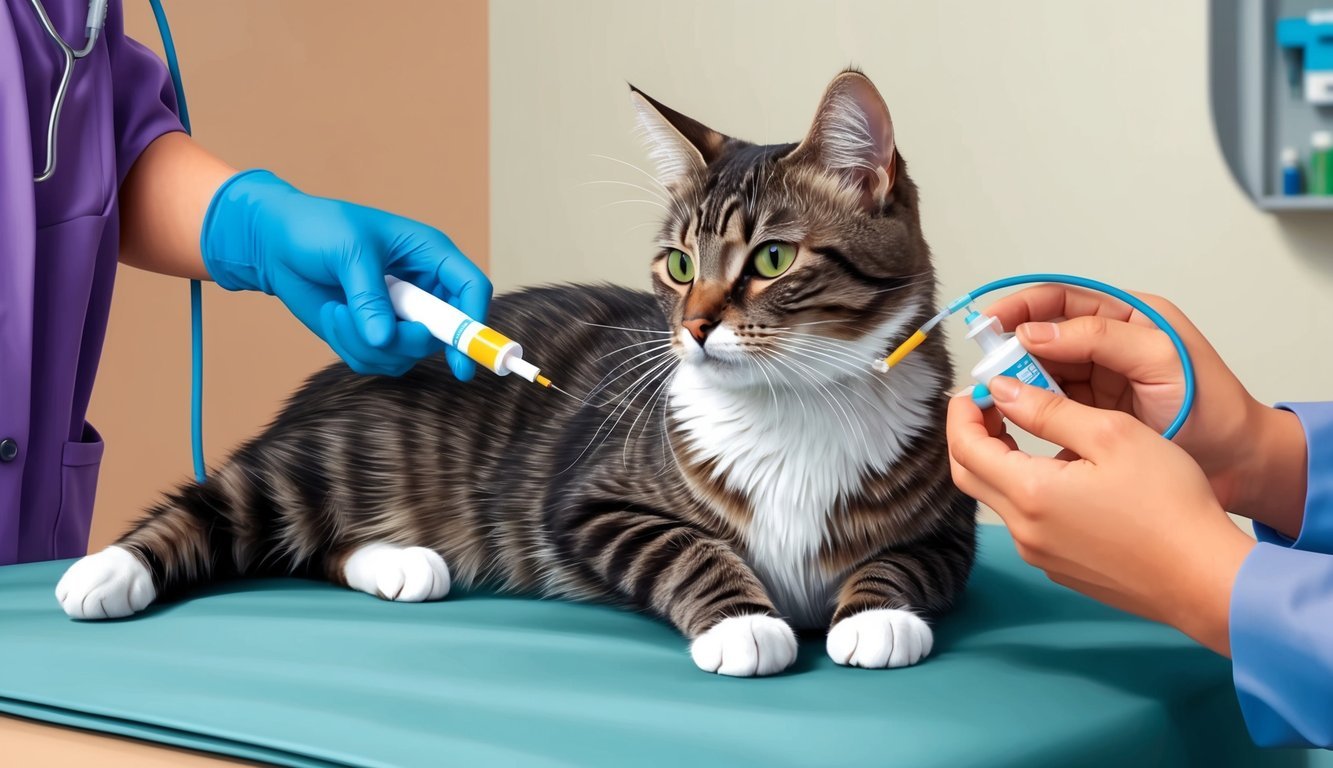
When dealing with low blood sugar in cats, both immediate interventions and long-term management strategies are crucial.
Knowing when and how to act can make a significant difference in your cat’s health.
Immediate Interventions
For cats displaying signs of hypoglycemia, swift action is essential.
If your cat is conscious and alert, offering a quick source of sugar can help.
- Honey or Karo Syrup: Applying a small amount of honey or Karo syrup on your cat’s gums can quickly raise their blood sugar levels.
- Intravenous Dextrose: If your cat is unconscious or unable to swallow, intravenous dextrose administered by a veterinarian is effective. This method delivers a concentrated sugar solution directly into the bloodstream for rapid results.
Always seek veterinary assistance after initial treatment to determine the underlying cause and prevent recurrence.
Long-Term Management
Long-term management involves addressing the root causes of low blood sugar.
Regular veterinary check-ups are vital to monitor your cat’s condition.
- Insulin Therapy: For diabetic cats, appropriate insulin doses can help maintain stable blood sugars. Your vet will guide you in finding the right dosage.
- Dietary Adjustments: A balanced diet tailored to your cat’s specific needs can prevent fluctuations in blood sugar. High-protein, low-carb diets are often beneficial.
- Oral Medications: New oral medications, like those approved recently, may offer alternatives or adjuncts to insulin therapy. Discuss these options with your veterinarian to ensure proper implementation.
With the right treatment plan, you can help manage your cat’s hypoglycemia effectively.
Managing a Diabetic Cat
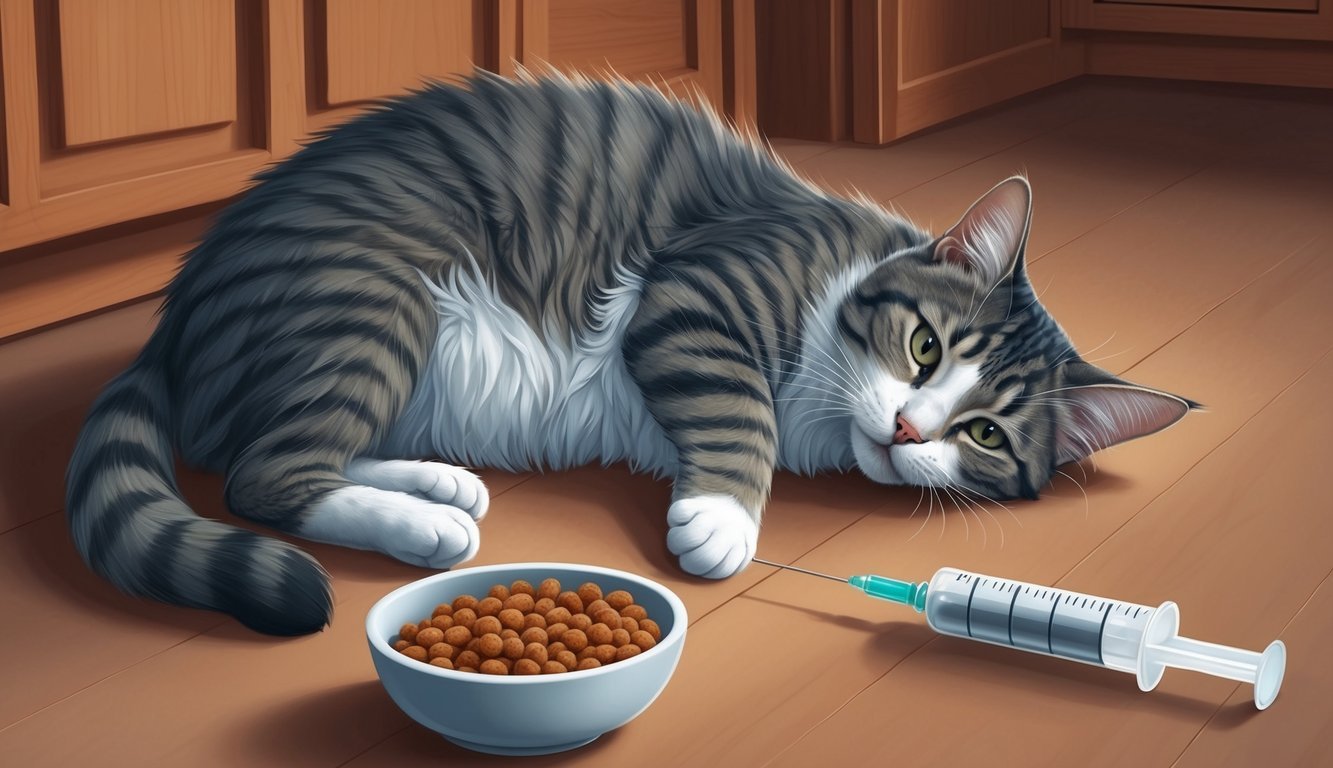
Caring for a diabetic cat requires attention to their diet and insulin treatment.
Proper management can help maintain stable blood sugar levels and improve their quality of life.
Diet and Nutrition
Feeding your diabetic cat a consistent, balanced diet is crucial.
Focus on high-protein, low-carbohydrate cat food to manage glucose levels effectively.
Canned food is often preferable to dry food, as it tends to have lower carbohydrate content and higher moisture levels.
Key points to remember include:
- Meal Timing: Serve meals at the same times daily to improve insulin effectiveness.
- Portion Control: Monitor portions to help manage weight and glucose spikes.
- Treats: If you offer treats, ensure they are low in carbohydrates and suitable for diabetic cats.
Consult your veterinarian to find the best diet tailored to your cat’s specific needs.
This can help achieve diabetic remission over time.
Monitoring and Adjusting Insulin
Regularly monitoring your cat’s blood glucose levels is essential in managing diabetes.
You should aim to check levels as recommended by your veterinarian, especially during adjustments to insulin dosage.
Be aware of signs indicating the need for insulin modification, such as:
- Persistent high blood sugar levels
- Symptoms of hypoglycemia like weakness or lethargy
Adapting insulin dosages should only be done under veterinary guidance.
Keep a record of your cat’s blood glucose readings and behaviors to aid in discussions with your vet.
Your attention can help sugar levels stay within a healthy range.
Complications and Prognosis

Low blood sugar in cats can lead to several complications that may affect their overall health.
Recognizing these issues early is essential for effective treatment and better outcomes.
Let’s explore some of the complications and what you can expect regarding the prognosis for your cat.
Recognizing Complications
Hypoglycemia can trigger a range of complications, particularly if it is severe or prolonged.
Some common signs you might notice include:
- Lethargy and Weakness: Your cat may appear unusually tired or have trouble moving.
- Neurological Problems: Disorientation, seizures, or even coma can occur.
- Increased Appetite: Cats may eat more as their body tries to compensate for low energy.
In addition, underlying conditions like liver disease or Addison’s disease can worsen symptoms.
Portosystemic shunts may lead to fluctuating glucose levels, increasing the risk of hypoglycemia.
It’s crucial to monitor your cat closely, especially if they’ve had recent hypoglycemic episodes.
Outlook for Feline Hypoglycemia
The prognosis for a cat with hypoglycemia largely depends on the cause and how quickly you seek treatment.
In many cases, if treated promptly, cats can recover fully and avoid lasting complications.
Regular monitoring is key.
If the cause is linked to diabetes, it’s essential to manage their glucose levels to prevent diabetic neuropathy over time.
Some cats may achieve diabetic remission, where they no longer need insulin.
If there’s an underlying disorder like a tumor or kidney disease, your veterinarian will devise a longer-term treatment plan to manage those issues, improving your cat’s outlook.
Early detection and treatment can significantly enhance recovery chances.
Support and Recovery

Managing low blood sugar in cats involves careful home care and regular veterinary support.
Your efforts at home, along with veterinary guidance, can significantly aid in recovery and management.
Home Care Strategies
At home, monitoring your cat’s glucose levels is crucial.
Consider investing in a glucose monitor to check their blood sugar regularly, especially if they have a history of hypoglycemia.
This helps you catch any fluctuations early.
Establish a consistent feeding schedule with high-quality cat food that has balanced nutrients.
Small, frequent meals can stabilize blood sugar levels.
If your cat seems weak or disoriented, offer a small amount of honey or syrup to raise their glucose quickly.
Observe for symptoms like lethargy or seizures.
If you notice these, contact your vet immediately.
Keeping your cat comfortable and calm is essential during recovery.
Provide a safe environment free from stressors.
Follow-Up Veterinary Care
Regular check-ups are key to ensuring your cat’s ongoing health.
Your vet may recommend blood tests to monitor glucose levels and assess for underlying conditions like diabetes or insulinomas.
Discuss any concerns you have about your cat’s behavior or weight with your vet.
They might adjust medication or suggest dietary changes based on your observations.
Follow your vet’s guidance on administering insulin if prescribed.
Understanding the correct dosage and timing is vital for effective management.
Don’t hesitate to contact your vet with any questions regarding the care plan you’ve established together.
Frequently Asked Questions
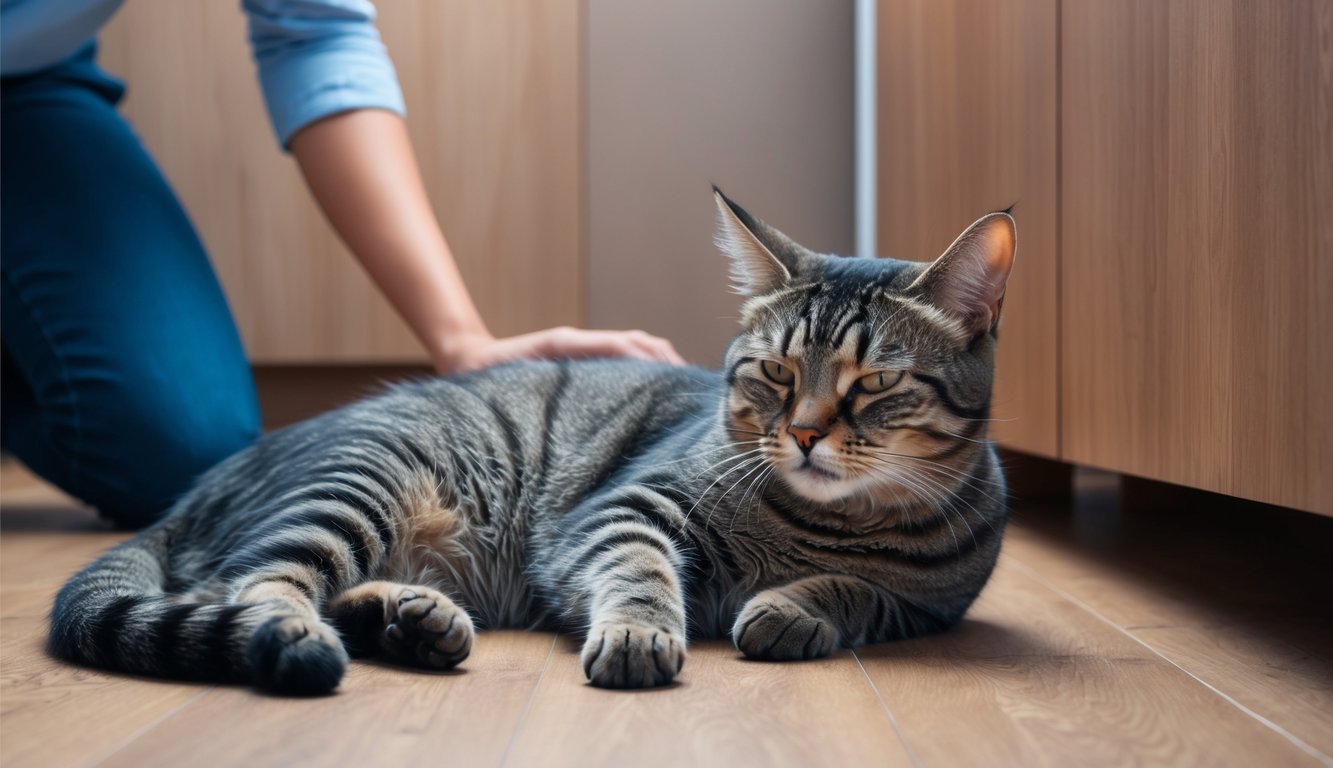
Understanding low blood sugar in cats involves recognizing symptoms and knowing how to respond appropriately.
Here are some common questions pet owners have about managing this condition.
What are the symptoms of hypoglycemia in felines?
Cats experiencing hypoglycemia may show a range of symptoms including weakness, disorientation, and lethargy.
In more severe cases, they might collapse or lose consciousness.
You might also notice shaking or unusual behavior as their energy levels drop.
How can you manage hypoglycemia in your cat at home?
If your cat shows signs of low blood sugar, you can administer a small amount of corn syrup or honey.
Apply it to their gums for quick absorption.
Keep a close eye on their response and contact your veterinarian if symptoms persist or worsen.
What should you feed a cat experiencing a drop in blood sugar?
Feeding your cat a diet rich in protein and moderate in carbohydrates can help stabilize their blood sugar levels.
Offer small, frequent meals to prevent fluctuations.
If your cat is experiencing hypoglycemic episodes, consult your vet for specific dietary recommendations.
At what glucose level should you start worrying about your cat’s health?
A blood glucose level below 70 mg/dL is generally considered low and can warrant immediate concern.
If your cat’s glucose levels drop dangerously low, it’s crucial to seek veterinary assistance.
Monitoring glucose levels regularly is key for diabetic cats.
How do veterinarians address hypoglycemia in cats?
Veterinarians typically treat hypoglycemia with intravenous dextrose to rapidly elevate blood glucose levels.
They may also perform tests to determine the underlying cause of the hypoglycemia, ensuring a comprehensive treatment plan.
Ongoing management may involve adjusting insulin doses for diabetic cats.
Can you recognize the early signs of diabetic ketoacidosis in felines?
Yes, early signs include excessive thirst, frequent urination, and a lack of appetite.
You might also notice lethargy and possible vomiting.
Recognizing these symptoms early can help prevent the progression to more severe health issues.
If you suspect diabetic ketoacidosis, contact your veterinarian immediately.

